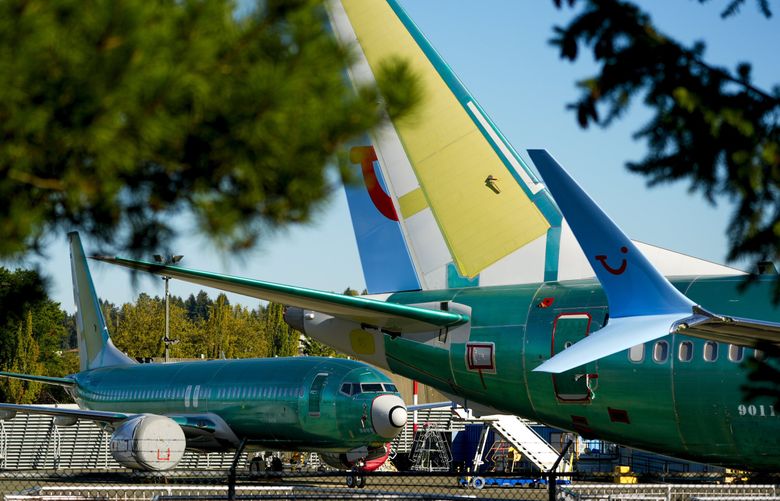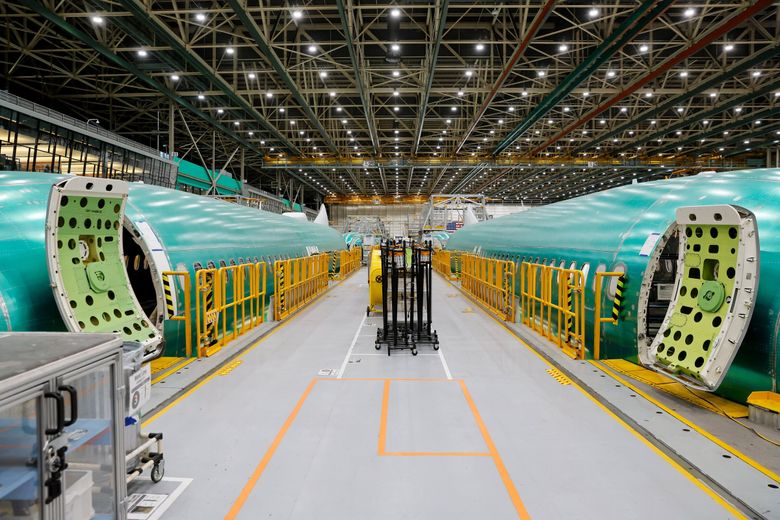Boeing work instructions inadequate for years before blowout, NTSB finds
July 10, 2025 at 4:38 pm


Unpainted 737 MAX aircraft are seen Sept. 24 at the Boeing plant in Renton. Federal accident investigators said Boeing and the FAA should have done better quality-control work before the blowout of a door panel on an Alaska Air 737 MAX aircraft in January 2024. (Lindsey Wasson / The Associated Press)
By
Lauren Rosenblatt
Seattle Times business reporter
The panel blowout aboard an Alaska Airlines Boeing 737 was the result of more than four missing bolts, the National Transportation Safety Board reiterated in its final investigation report into the incident released Thursday.
The Jan. 5, 2024, blowout — which occurred shortly after the Alaska Airlines plane took off from Portland — happened because of long-term shortcomings at Boeing and the Federal Aviation Administration, the agency tasked with overseeing the manufacturer’s quality and safety processes, the NTSB determined.
Because Boeing’s instructions for employees lacked “clarity and conciseness,” workers missed opportunities to note that the panel had been removed during the aircraft’s assembly, the NTSB said. The panel was incorrectly reinstalled but, without a record of the work being done, it was not reinspected and left the factory with four crucial bolts missing.
Boeing knew of the deficiencies in its work instructions for a decade, the NTSB said in its report, but both Boeing and the FAA failed to fix the flawed process.
The blame for the panel blowout, then, did not hang on the shoulders of workers who failed to install the four bolts that would have held the panel in place, but instead on Boeing and the FAA, the NTSB said.
The safety board has made these declarations before, including at a June hearing when board members discussed the results of the 18-month-long investigation. NTSB Chair Jennifer Homendy said at that time that “an accident like this only happens when there are multiple system failures,” adding that the “deficiencies that led to this accident should have been evident” to Boeing and the FAA.
The final report released Thursday delves into more detail about what the NTSB found following months of interviews with Boeing and FAA employees, including where its record-keeping processes and work instructions for employees fell short.
What went wrong
On Jan. 5, 2024, on Alaska Airlines Flight 1282, the first officer completed an external preflight walkaround and found nothing abnormal with the MAX 9, which had rolled out of Boeing’s Renton factory months before.
The flight’s taxi, takeoff and initial climb was uneventful, until the plane reached about 14,830 feet, when the cabin pressure suddenly dropped.
The captain heard flight attendants talking about a hole in the plane but, unable to communicate with one another, both the flight and cabin crews were uncertain about what had happened, the NTSB found.
The flight landed safely back in Portland, with some passengers and crew members reporting minor injuries. The left side of the plane had a hole that measured roughly 29 inches wide and 59 inches high. A seatback tray table, two seat headrests and nearby cabin interior panels were missing.
Months earlier, Boeing mechanics in the company’s Renton factory had removed that panel, known as a door plug because it fills a hole in the fuselage that can be used as an emergency exit for high-density seating aircraft.
Mechanics removed the panel to fix a problem with rivets. But, the NTSB found, none of the personnel working on the door plug generated a record that the panel had been removed.
Boeing mechanics then reinstalled the door plug, without four bolts meant to hold it in place. Because there was no removal record, no one conducted a final inspection to sign off that the door plug was reinstalled correctly.
After the plane was delivered to Alaska Airlines — without the bolts in place — the door plug slowly slid upwards, until, during Flight 1282, it moved far enough up to separate from stop fittings pinning it in place. The loosened plug then flew out of the airframe, leaving a hole in the side of the aircraft.
The four bolts meant to hold the door plug in place were never found, the NTSB said.
Missed chances
The NTSB determined that Boeing workers missed two opportunities to prompt a reinspection of the door plug after it had been removed and reinstalled.
Though both were needed to properly follow Boeing’s work processes, just one of the two could have prompted a second look and caught the missing bolts, preventing the near catastrophe.
Boeing’s procedures direct workers to generate a “removal record” to document what parts of the airplane they took off and what tasks are then needed to assure the parts are reinstalled correctly.
That removal record is required whenever there is a “disturbance of a previously accepted installation,” according to the NTSB’s report. In other words, whenever the removal would affect a job task that had already been inspected and approved. The removal would then require the earlier task be reinspected.
Related on alaska flight 1282
In one early discussion about the door plug, the NTSB learned that a senior manager told the door manager that “if removal (is) needed, a removal needs to (be) written first.”
Most Read Business Stories Still, the NTSB determined that neither the door team manager nor any of the door team personnel on duty had any experience opening a door plug, nor any knowledge of who actually performed the work. A removal record was not generated.
Separately, Boeing also incorporates a “short stamp process,” which is meant to document work that couldn’t be completed in its initial phase of production and therefore has to “travel” through the factory. A “stamp” indicates that a portion of the work has been completed.
In this case, Boeing’s postaccident review showed the short stamp process “did not clearly define the work remaining,” the NTSB said.
Though the short stamp process would not have negated the need for a removal record, it may have prompted a second look at the area and found that the bolts were missing, the NTSB said in its final report.
A systemic problem
The NTSB did not identify any individuals who worked on the removal and reinstallation of the door plug, and it’s not clear if the agency knows who performed those tasks.
But, the board made it clear in its final report that the incident was not the result of a single worker or group of workers who missed a crucial step in Boeing’s process. Instead, it was the result of a companywide problem that had long been identified.
It found that Boeing’s instructions for removal records “lacked clarity, conciseness and ease of use.”
The specific instructions for generating a removal record were more than 50 pages long, directed workers to other instructions and “provided more exceptions about when a removal record was not needed than direction indicating when it was,” the NTSB wrote in its report.
“Boeing lacked the comprehensive training and clear guidance needed to ensure that its … 737 door team personnel and others could consistently meet quality and safety standards,” the NTSB continued.
Boeing had been aware that its work instructions were not preparing employees to follow the removal process for at least 10 years, the agency determined. Those specific work instructions were referenced in 16 compliance issue reports to the FAA from 2018 to 2023, including instances of workers failing to generate a removal when it was required, the NTSB found.
Boeing had “substantively” revised the instructions 11 times between 2013 and 2023, but its proposed changes, which had been accepted by the FAA, were “ineffective,” the NTSB said. Furthermore, the FAA lacked the processes to keep track of discrepancies and nonconformances related to Boeing’s removal process.
A call for change
Boeing has since updated its instructions and training, including adding more training on when and why removal documentation is required.
Still, the NTSB said in its report that “effective guidance and recurrent training are critical” to ensure employees know what to do when a removal arises.
The NTSB, which does not have regulatory or enforcement authority, recommended Boeing update its on-the-job training to identify tasks that are necessary for manufacturing workers to be considered “fully qualified.”
That’s in part because the NTSB found that training for “nonroutine tasks,” including opening a door plug and generating a removal record, was not part of a structured program, leaving many workers unprepared.
The NTSB also recommended Boeing implement a grading system for its training program and develop a process to identify quality issues that result from human error, in order to prevent the same error from reoccurring.
When it comes to Boeing’s oversight, the NTSB said it was “encouraged by the FAA’s initial progress” but recommended the agency revise its compliance enforcement system, audit activity and record-keeping system.
It also recommended that the FAA convene an independent panel to review Boeing’s safety culture.
In response to the NTSB’s recommendations first publicized at the June hearing, the FAA said it has “fundamentally changed how it oversees Boeing … and we will continue this aggressive oversight to ensure Boeing fixes its systemic production-quality issues.”
A Boeing spokesperson said Thursday the company would ” review the final report and recommendations as we continue to implement improvements.”
“We at Boeing regret this accident and continue to work on strengthening safety and quality across our operations,” the spokesperson said.
Lauren Rosenblatt: 206-464-2927 or lrosenblatt@seattletimes.com. Lauren Rosenblatt is a Seattle Times business reporter covering Boeing and the aerospace industry.
seattletimes.com |






